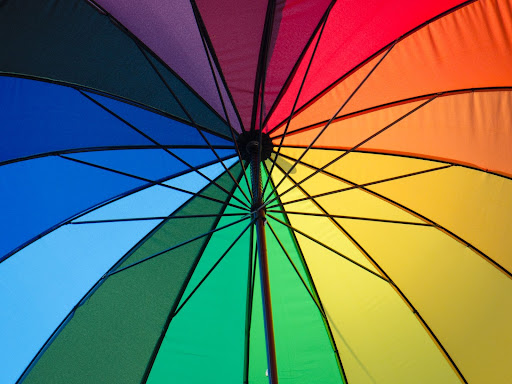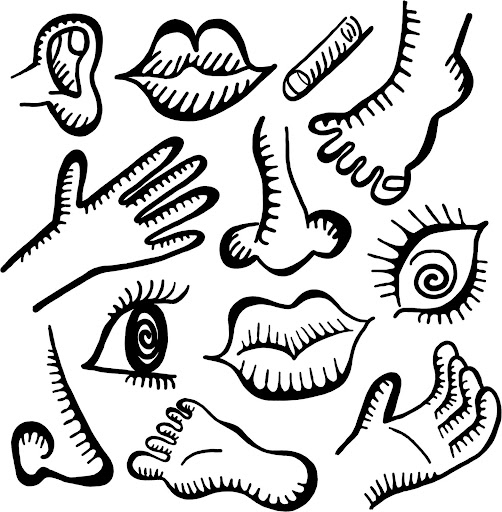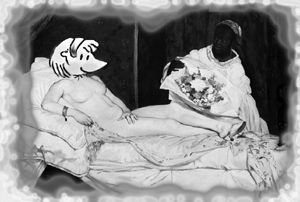Module 04: L’identité
Première Partie: Le portrait physique, Explication de grammaire
In this section:
- les couleurs et les adjectifs
- Les articles définis
- le portrait physique – avoir
- les pronoms non-binaires
les couleurs et les adjectifs – colors and adjectives

| les couleurs (f)
blanc / blanche bleu / bleue gris / grise jaune marron (invariable) noir / noire orange (invariable) rouge vert / verte violet / violette |
colors
white blue gray yellow brown black orange red green purple |
Les articles définis – Definite articles

The definite article (le, la, l’, les) is often used with parts of the body instead of a possessive determiner (mon, ma, mes, etc.). Sentences with this structure always use the verb avoir to indicate that the possessor is the subject of the sentence. The following French sentences are equivalent.
![]()

|
![]()
However, an indefinite article is used if an adjective comes before the part of the body:
![]()
|
![]()
The definite article is also always used when pronominal verbs refer to parts of the body.
le portrait physique – avoir – to have
In French, there are two main verbs used to describe someone’s physical attributes. You may use “être” – to be – to describe how they are, or use the verb avoir – to have – to describe certain features.
Elle est blonde – using “être”. Notice the adjective “blond” agrees with the person’s gender here.
or
Elle a les cheveux blonds – using “avoir”. The adjective “blond” agrees with the noun it’s describing – cheveux (hairs) are plural and masculin.
J‘ai – I have
Tu as– you have
Il / elle /iel /on a – he/she/they/one has
nous avons – we have
vous avez – you (all) have
ils / elles / iels ont – they have
les pronoms non-binaires – Non-binary pronouns
iel = “they” (singular) “Iel aime jouer au foot.”
iels = “they” (plural) “Iels aiment danser.”
non-binary options: adjectives
The following suggestions for how to describe non-binary people is adapted from Julia Spiegelman’s “Student Guide to Non-Binary French”:
As mentioned in previous modules, the middot (point médian) can be used in inclusive written French to suggest gender neutrality: for example, les étudiant·e·s can include students of all genders.
- Example: Sam est fatigué·e.
For the adjectives discussed above in BANGS, the following are possible options:
Beau /belle:
Iel est belleau ou bel.
Joli / jolie:
Iel est jolix.
Vieux / vieille:
Iel est vieil
Bon / bonne
Iel est ban
Grand / grande
Iels est grans ou granx.
Petit / petite
Iel est petit·e
Vocabulaire LGBT+ en français
Identités et expression de genre et sexualité
-
- agenre – agender
- androgyne – androgynous
- aromantique – aromantic
- asexuel·le – asexual
- bigenre – bigender
- bisexuel·le – bisexual
- cisgenre – cisgender
- demifille – demigirl
- demigarçon – demiboy
- demisexuel·le – demisexual
- féminin·e – feminine
- gay / gai – gay
- genre fluide / genderfluid – genderfluid
- genderqueer – genderqueer
- genre neutre – gender neutral
- l’identité (f) de genre – gender identity
- intersexe – intersex
- hétérosexuel·le / hétéro – heterosexual
- lesbien·ne – lesbian
- masculin·e – masculine
- non-binaire – non-binary
- l’orientation sexuelle – sexual orientation
- pangenre – pangender
- pansexuel·le – pansexual
- une personne trans – a trans person
- queer – queer
- en questionnement – questioning
- transgenre / trans – transgender
Actions
- s’identifier comme – to identify as
- manifester, militer (pour) – to protest, advocate (for)
- porter un binder – to wear a binder
- se questionner sur le genre – to question one’s gender
- sortir du placard, faire son coming-out – to come out
- suivre une hormonothérapie – to take hormone therapy
- transitionner – to transition
La société
- la communauté LGBT/queer – the LGBT/queer community
- les droits (m) – rights
- genre neutre – gender-neutral
- hétéronormatif/ve – heteronormative
- l’hétéronormativité (f) – heteronormativity
- homophobe – homophobic
- l’homophobie (f) – homophobia
- le langage neutre – gender-neutral language
- les lois (f) – laws
- mégenrer – to misgender
- un·e militant·e – an activist
- les normes (f) – norms
- le patriarcat – the patriarchy
- le sexisme – sexism
- un spectre – a spectrum
- la transphobie – transphobia
- transphobe – transphobic
Phrases
- Tu t’identifies comment?
- Je m’identifie comme… / Je suis…
- Quel est ton pronom? / Tu utilises quel pronom ?
- Mon pronom est… / J’utilise le(s) pronom(s)…
Le français non-binaire
Nouns: How to call people
Nouns that carry a gender unrelated to the person they designate:
- la personne – the person
- l’individu – the individual
- le personnage – the character
Ex: Alex est un individu non-binaire et pansexuel.
Son ami·e, Kyle, est une personne genderqueer et bisexuelle.
Nouns that stay the same regardless of gender:
- ado – teenager
- jeune – young person
- enfant – child
- élève – student
- adulte – adult
- partenaire – (work) partner
- collègue – colleague
- athlète – athlete
- touriste – tourist
Words to describe people and relationships
| m | f | nb | |
| child | fils | fille | enfant |
| sibling | frère | sœur | *frœur, adelphe |
| friend | ami | amie | ami·e |
| partner | petit-ami | petite-amie | petit·e-ami·e |
* marks non-traditional words and uses – you won’t find these in a dictionary (yet).
Adjectives: How to describe people
Here are some adjectives that don’t change based on gender :
- adorable – adorable
- agréable – pleasant
- aimable – likable
- calme – calm
- désagréable – unpleasant
- dynamique – dynamic
- énergique – energetic
- lunatique – moody
- pauvre – poor
- riche – rich
- sage – wise, well-behaved
- sympathique/sympa – nice
- timide – shy
Punctuated forms using the middot (point médian), dash, or period are often used in inclusive written French to suggest gender neutrality: for example, les étudiant·e·s can include students of all genders. These forms are widely understood.
- Example: Sam est fatigué·e / fatigué.e / fatigué-e.
New, alternative endings for gender-neutral forms are suggested in the table below. These are recommended by a Québecois organization for trans inclusion, Fondation Émergence


